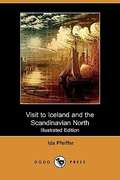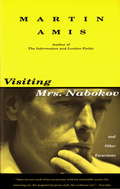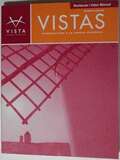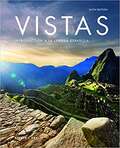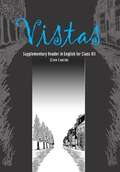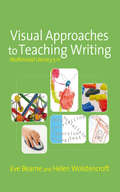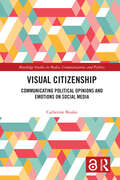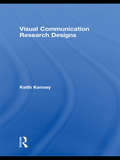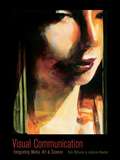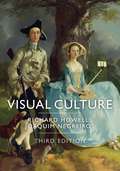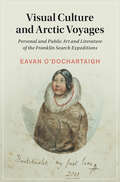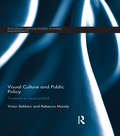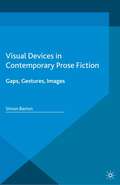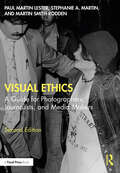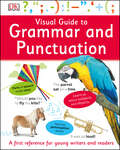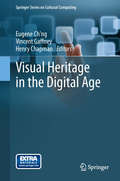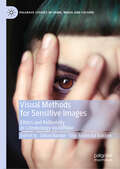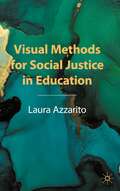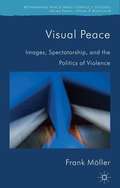- Table View
- List View
Visit to Iceland and the Scandinavian North
by Ida PfeifferA besetting sin of the Icelanders is their drunkenness. Their poverty would probably not be so great if they were less devoted to brandy, and worked more industriously. <P> <P> It is dreadful to see what deep root this vice has taken. Not only on Sundays, but also on week-days, I met peasants who were so intoxicated that I was surprised how they could keep in their saddle. I am, however, happy to say that I never saw a woman in this degrading condition.
Visiting Mrs. Nabokov
by Martin AmisTo this tantalizing nonfiction collection Martin Amis brings the same megawatt wit, wickedly acute perception, and ebullient wordplay that characterize his novels. He encompasses the full range of contemporary politics and culture (high and low) while also traveling to China for soccer with Elton John and to London's darts-crazy pubs in search of the perfect throw. Throughout, he offers razor-sharp takes on such subjects as:American politics: "If history is a nightmare from which we are trying to awake, then the Reagan era can be seen as an eight-year blackout. Numb, pale, unhealthily dreamless: eight years of Do Not Disturb."Chess: "Nowhere in sport, perhaps in human activity, is the gap between the tryer and the expert so astronomical.... My chances of a chess brilliancy are the 'chances' of a lab chimp and a type writer producing King Lear."From the Trade Paperback edition.
Vistas Introduccion A La Lengua Espanola
by José A. Blanco Philip Redwine DonleyVistas Introduccion A La Lengua Espanola, Student Edition
Vistas Introduccion a La Lengua Espanola
by Jose A. BlancoWith the interactive grammar and vocabulary practice, engaging media, and communicative tasks in Vistas, introductory students gain confidence and the cultural understanding needed to take them to the next level. Continuing in the tradition of delivering a fresh, student-friendly approach, the 6th Edition makes students’ learning—and instructor’s teaching—easier and more successful.
Vistas in Reading Literature: Silver Level
by Donna NortonA reader on the fifth-grade level with stories, poems, plays, and nonfiction by world-famous authors. Includes study questions, activities, and exercises.
Vistas: Supplementary Reader in English (Core Course) class 12 - NCERT - 23
by National Council Of Educational Research And Training"Vistas" is an English textbook for Class 12 published by NCERT. It contains a collection of diverse short stories written by renowned authors. The book aims to enhance students' reading comprehension, vocabulary, and analytical skills while exposing them to different literary genres. Some notable stories include "The Third Level" by Jack Finney, exploring escapism; "The Tiger King" by Kalki Krishnamurthy, a satirical account of a tiger-obsessed king; "Journey to the End of the Earth" by Tishani Doshi, reflecting on self-discovery; "Memories of Childhood" by Zitkala-Sa, an autobiographical account; and "The Enemy" by Pearl S. Buck, portraying complex dynamics during WWII. These stories encourage critical analysis and provide insights into social, cultural, and human aspects.
Visual Approaches to Teaching Writing: Multimodal Literacy 5 - 11 (Published in association with the UKLA)
by Helen Wolstencroft Ms Eve BearneIncludes CD-Rom Why are visual approaches to literacy important? Children's experience of texts is no longer limited to words on printed pages - their reading and writing worlds are formed in multimodal ways, combining different modes of communication, including speech or sound, still or moving images, writing and gesture. This book is a practical guide for teachers in making sense of multimodal approaches to teaching writing. The book covers topics such as: - The design of multimodal texts and the relationships between texts and images - How to build a supportive classroom environment for analysing visual and audiovisual texts, and how to teach about reading images - How to plan a teaching sequence leading to specific writing outcomes - Examples of teaching sequences for developing work on narrative, non-fiction and poetry - Formative and summative assessment of multimodal texts, providing levels for judging pupil development, and suggestions for moving pupils forward - How to write, review and carry out a whole school policy for teaching multimodal writing The book is accompanied by a CD, which contains a range of examples of children's multimodal work, along with electronic versions of the activities and photocopiable sheets from the book, and material designed for use with interactive whiteboards. It will be a valuable resource for primary teachers, literacy co-ordinators and students on initial teacher training courses. Visit the UKLA's website : here
Visual Arts in the Worshiping Church (Calvin Institute of Christian Worship Liturgical Studies)
by Nicholas Wolterstorff Lisa DeBoerAlthough numerous studies have examined biblical and theological rationales for using the visual arts in worship, this book by Lisa J. DeBoer fills in a piece of the picture missing so far — the social dimensions of both our churches and the various art worlds represented in our congregations. The first part of the book looks at Orthodoxy, Catholicism, and Protestantism in turn — including case studies of specific congregations — showing how each tradition’s use of the visual arts reveals an underlying ecclesiology. DeBoer then focuses on six themes that emerge when Orthodox, Catholic, and Protestant uses of the visual arts are examined together — the arts as expressions of the church’s local and universal character, the meanings attributed to particular styles of art for the church, the role of the arts in enculturating the gospel, and more. DeBoer’s Visual Arts in the Worshiping Church will focus and deepen the thinking of pastors, worship leaders, artists, students, and laypeople regarding what the arts might do in the midst of their congregations.
Visual Arts in the Worshiping Church (Calvin Institute of Christian Worship Liturgical Studies)
by Lisa DeBoerAlthough numerous studies have examined biblical and theological rationales for using the visual arts in worship, this book by Lisa J. DeBoer fills in a piece of the picture missing so far — the social dimensions of both our churches and the various art worlds represented in our congregations. The first part of the book looks at Orthodoxy, Catholicism, and Protestantism in turn — including case studies of specific congregations — showing how each tradition&’s use of the visual arts reveals an underlying ecclesiology. DeBoer then focuses on six themes that emerge when Orthodox, Catholic, and Protestant uses of the visual arts are examined together — the arts as expressions of the church&’s local and universal character, the meanings attributed to particular styles of art for the church, the role of the arts in enculturating the gospel, and more. DeBoer&’s Visual Arts in the Worshiping Church will focus and deepen the thinking of pastors, worship leaders, artists, students, and laypeople regarding what the arts might do in the midst of their congregations.
Visual Character Development in Film and Television: Your Character is Your Canvas
by Michael Hanly Elisabeth RowneyThis book takes a unique look at visual character development in motion pictures and television by using famous works of art combined with modern works of film and television to demonstrate how to weave a visual tale. In a single shot or scene, what should we reveal about a character? What should we conceal? How can we show a character’s progression over time? In Visual Character Development in Film and Television, authors Michael Hanly and Elisabeth Rowney explain how to create compelling visual characters for the screen by analyzing fine art aesthetics and combining them with modern cinematic techniques. Full-color chapters cover character-driven approaches to costume design and makeup application, production design, cinematography and lighting, plot development, editing considerations, and more. By exploring how surroundings, habits, lifestyles – even the color of a sweater – can tell us more about a character on the screen than what can be said in dialogue alone, this book will prove a valuable resource for anyone wanting to take their filmmaking to the next level.
Visual Citizenship: Communicating political opinions and emotions on social media (Routledge Studies in Media, Communication, and Politics)
by Catherine BoukoThis book explores visual political engagement online – how citizens participate in the dynamism of life in society by expressing their opinions and emotions on various issues of democratic life in image-based social media posts, independently of collective actions.Looking beyond large digital social movements to focus on the everyday, the book provides a well-documented and comprehensive framework of key notions, concrete methods and examples of empirical insights into everyday visual citizenship on social media. It shows how the visual has become ubiquitous in citizens’ communication on social media, focusing on how citizens use visual content to express their emotions and opinions on social media platforms when they discuss politics in a large sense.With this book, every reader interested in political communication, visual communication and/or new media is fully equipped to analyse everyday visual citizenship on social media platforms.The Open Access version of this book, available at http://www.taylorfrancis.com, has been made available under a Creative Commons [Attribution-Non Commercial-No Derivatives (CC-BY-NC-ND)] 4.0 license.
Visual Communication Research Designs
by Keith KenneyVisual Communication Research Designs provides a step-by-step guide for designing research involving visuals relevant to communications media. This volume explains the process from conceptualization to research questions, instrumentation, analysis, and reliability and validity checks. It also addresses the lack of sufficient methods to answer theoretical questions attending visual communication. This resource has been developed in response to the circumstance in which, in many cases, the methodologies used for verbal and textual communications are inappropriate or ineffective when applied or adapted for the study of visual communications. Additionally, research articles from ethnography, action research, rhetoric, semiotics, psychology, cultural studies, and critical theory often do not use examples appropriate to visual communication readers. To address these issues, this book explains in clear and straightforward language key research designs, including new methodologies, that are appropriate for scholars and students conducting visual communication research. Organized into three parts -- production, analysis, and effects of visuals – this research text provides guidance in using, interpreting and measuring the effects of visual images. It addresses such topics as: producing photographs and video that can be used as research data; interpreting images that already exist; measuring the effects of visuals and to understand their use by different groups. Ethical issues are included, as well as a discussion of the advantages and limitations of each method. "War stories" are provided by experienced researchers, who discuss a particular research project and explain pitfalls to avoid, as well as what to do when problems occur. The primary audiences are scholars, researchers, and students conducting research on motion pictures, video, television, photographs, illustrations, graphics, typography, political cartoons, comic books, animation, and other media with a visual component. Individuals will use this text whenever they need to conduct research that involves visuals in the media. The book will be a required text for advanced courses in visual culture, seminars on visual communication research, and other research methods courses integrating a visual component.
Visual Communication: Integrating Media, Art, and Science
by Rick Williams Julianne NewtonA well-rounded education in the 21st century requires not just verbal and mathematical proficiency, but also the ability to interpret, critique, create, and use visual communication on sophisticated levels. In today’s visual world, it is critically important to hold an appreciation for the profound effects imagery has on individuals and the communities in which they live. Visual Communication focuses on cultivating visual and media literacy from both consumption and production points of view and introduces students to the application of intuitive intelligence to a visual context. Innovative in its field, it provides a solid theoretical overview of the most advanced thinking and research about visual communication, teaching readers how to apply theory to enhance their understanding of and work with images. This book is intended for students in visual literacy and communication courses. It can also be used in photojournalism courses and other coursework with a visual component. Individuals interested in mass media studies will likewise find the book to be a worthwhile read.
Visual Culture
by Richard Howells Joaquim NegreirosThis is a book about how to read visual images: from fine art to photography, film, television and new media. It explores how meaning is communicated by the wide variety of texts that inhabit our increasingly visual world. But, rather than simply providing set meanings to individual images, Visual Culture teaches readers how to interpret visual texts with their own eyes. While the first part of the book takes readers through differing theoretical approaches to visual analysis, the second part shifts to a medium-based analysis, connected by an underlying theme about the complex relationship between visual culture and reality. The book is an ideal introduction for students taking courses in visual culture and communications in a range of disciplines, including media and cultural studies, sociology, and art and design.
Visual Culture and Arctic Voyages: Personal and Public Art and Literature of the Franklin Search Expeditions (Cambridge Studies in Nineteenth-Century Literature and Culture #136)
by Eavan O'DochartaighIn the mid-nineteenth century, thirty-six expeditions set out for the Northwest Passage in search of Sir John Franklin's missing expedition. The array of visual and textual material produced on these voyages was to have a profound impact on the idea of the Arctic in the Victorian imaginary. Eavan O'Dochartaigh closely examines neglected archival sources to show how pictures created in the Arctic fed into a metropolitan view transmitted through engravings, lithographs, and panoramas. Although the metropolitan Arctic revolved around a fulcrum of heroism, terror and the sublime, the visual culture of the ship reveals a more complicated narrative that included cross-dressing, theatricals, dressmaking, and dances with local communities. O'Dochartaigh's investigation into the nature of the on-board visual culture of the nineteenth-century Arctic presents a compelling challenge to the 'man-versus-nature' trope that still reverberates in polar imaginaries today. This title is also available as Open Access on Cambridge Core.
Visual Culture and Public Policy: Towards a visual polity? (Routledge Critical Studies in Public Management)
by Victor Bekkers Rebecca MoodyTraditionally, images have played an important role in politics and policy making, mostly in relation to propaganda and public communication. However, contemporary society is inundated with visual material due to the increasing ubiquity of media and visual technologies that facilitate the production, distribution and consumption of images in new and innovative ways. As such, a visual culture has emerged, and a number of authors have written on visual culture and the technologies which underlie it. However, a clear link to policy making is still lacking. This books links the emergence of this visual culture to policy making and explores how visual culture (and the growing number of technologies used to create and distribute images) influence the course, content and outcome of public policy making. It examines how visual culture and policy making in contemporary society are intertwined, elaborating concepts such as power, framing and storytelling. It then links this to technology, and the way this can enhance power, transparency, registration, surveillance and communication. Dealing with the entire cycle of public policy making, from agenda-setting, to policy design, decision making to evaluation, the book contains diverse international case studies including water management, risk management, live-stock diseases, minority integration, racism, freedom of speech, healthcare, disaster evaluation and terrorism.
Visual Devices in Contemporary Prose Fiction: Gaps, Gestures, Images
by Simon BartonThis book acknowledges that the reader of a novel looks at and sees the page before they begin to read any text placed upon it. Thus, any disruptions to how a traditional page 'should look' can have a large impact on the reading process. The book critically engages with the visual appearance of graphically innovative contemporary prose fiction.
Visual Ethics: A Guide for Photographers, Journalists, and Media Makers
by Paul Martin Lester Stephanie A. Martin Martin Smith-RoddenAn indispensable guide to visual ethics, this book addresses the need for critical thinking and ethical behavior among students and professionals responsible for a variety of mass media visual messages. Written for an ever-growing discipline, authors Paul Martin Lester, Stephanie A. Martin, and Martin Rodden-Smith give serious ethical consideration to the complex field of visual communication. The book covers the definitions and uses of six philosophies, analytical methods, cultural awareness, visual reporting, documentary, citizen journalists, advertising, public relations, typography, graphic design, data visualizations, cartoons, motion pictures, television, computers and the web, augmented and virtual reality, social media, the editing process, and the need for empathy. At the end of each chapter are case studies for further analysis and interviews with thoughtful practitioners in each field of study, including Steven Heller and Nigel Holmes. This second edition has also been fully revised and updated throughout to reflect on the impact of new and emerging technologies. This book is an important resource for students of photojournalism, photography, filmmaking, media and communication, and visual communication, as well as professionals working in these fields.
Visual Ethics: A Guide for Photographers, Journalists, and Media Makers
by Paul Martin Lester Stephanie A. Martin Martin Smith-RoddenAn indispensable guide to visual ethics, this book addresses the need for critical thinking and ethical behavior among students and professionals responsible for a variety of mass media visual messages.Written for an ever-growing discipline, authors Paul Martin Lester, Stephanie A. Martin, and Martin Rodden-Smith give serious ethical consideration to the complex field of visual communication. The book covers the definitions and uses of six philosophies, analytical methods, cultural awareness, visual reporting, documentary, citizen journalists, advertising, public relations, typography, graphic design, data visualizations, cartoons, motion pictures, television, computers and the web, augmented and virtual reality, social media, the editing process, and the need for empathy. At the end of each chapter are case studies for further analysis and interviews with thoughtful practitioners in each field of study, including Steven Heller and Nigel Holmes. This second edition has also been fully revised and updated throughout to reflect on the impact of new and emerging technologies.This book is an important resource for students of photojournalism, photography, filmmaking, media and communication, and visual communication, as well as professionals working in these fields.
Visual Guide to Grammar and Punctuation
by DKA clear, precise, and comprehensive book that will give children the tools to build confidence in reading, writing, and comprehension through visual explanation.From when to use a preposition or pronoun to how to use a comma or colon, Visual Guide to Grammar and Punctuation covers all the most important grammar topics in DK's signature style. Each example provided is supported by a picture, making it accessible and comprehensible, and clear and simple text and repetition help to solidify knowledge and understanding.Visual Guide to Grammar and Punctuation will improve a child's confidence in using the building blocks of reading and writing, and is a book they will refer to again and again.
Visual Heritage in the Digital Age
by Eugene Ch'Ng Vincent Gaffney Henry ChapmanHeritage is everywhere, and an understanding of our past is increasingly critical to the understanding of our contemporary cultural context and place in global society. Visual Heritage in the Digital Age presents the state-of-the-art in the application of digital technologies to heritage studies, with the chapters collectively demonstrating the ways in which current developments are liberating the study, conservation and management of the past. Digital approaches to heritage have developed significantly over recent decades in terms of both the quantity and range of applications. However, rather than merely improving and enriching the ways in which we understand and engage with the past, this technology is enabling us to do this in entirely new ways. The chapters contained within this volume present a broad range of technologies for capturing data (such as high-definition laser scanning survey and geophysical survey), modelling (including GIS, data fusion, agent-based modelling), and engaging with heritage through novel digital interfaces (mobile technologies and the use of multi-touch interfaces in public spaces). The case studies presented include sites, landscapes and buildings from across Europe, North and Central America, and collections relating to the ancient civilisations of the Middle East and North Africa. The chronological span is immense, extending from the end of the last ice age through to the twentieth century. These case studies reveal new ways of approaching heritage using digital tools, whether from the perspective of interrogating historical textual data, or through the applications of complexity theory and the modelling of agents and behaviours. Beyond the data itself, Visual Heritage in the Digital Age also presents fresh ways of thinking about digital heritage. It explores more theoretical perspectives concerning the role of digital data and the challenges that are presented in terms of its management and preservation.
Visual Journalism and Verification at War: Norwegian and Swedish News Outlets Covering Ukraine (Disruptions)
by Maria Nilsson Anne Hege SimonsenConsidering the visual coverage of the war in Ukraine, this book provides critical insights into how newsrooms make use of visual materials, how visuals partake in journalistic storytelling in a modern wartime context, and how visual journalism practices affect the news media’s role as arbiter of accuracy and ethics.Based on a mixed-methods study, including analyses of selected visually driven news stories and interviews with media professionals in Norwegian and Swedish national media outlets houses, this book examines the news media’s approach to the visual coverage of the war in Ukraine following Russian invasion in 2022. The work is theoretically underpinned by ongoing boundary work within journalism, and editorial negotiations over issues such as verification, source criticism, and trust; witnessing and ways of seeing; and ethical gatekeeping in photojournalism. At a juncture of rising concerns over AI, public distrust, and propaganda, this study adds a real-time aspect to these debates and reveals challenges as well as emerging strategies in the unfolding coverage. Furthermore, the comparative Scandinavian context serves to highlight points of tension between the global and the local; between those newsrooms relying on global image brokers and those conducting their own in-house reporting.Written for researchers and advanced students of Visual Journalism and Conflict Reporting, this book is a timely intervention.
Visual Methods for Sensitive Images: Ethics and Reflexivity in Criminology On/Offline (Palgrave Studies in Crime, Media and Culture)
by Sidsel Harder Silje Anderdal BakkenThis edited book provides a toolbox for researchers and students working with sensitive images in criminological research on and offline. Across three sections on collecting, analysing and mediating sensitive visual data, the chapters cover a wide array of current examples and discussions of visual methods and ethics in contemporary, digital-life criminology. It reflects the experiences of influential and innovative scholars engaging in empirical analysis of images across various subfields within criminology, including with images that deal with crime, social problems and stigma. They emphasize the opportunity for gaining knowledge through visual analysis and include methodological discussions of how to approach such sensitive data material. Some chapters address visuals as data in mediated realities and the related methodological concerns. The book also contributes to discussing the various ethical sides to researching crime-related sensitive images, such as anonymity, consent, and access, but also relates to researcher reflexivity and protecting researchers' well-being.
Visual Methods for Social Justice in Education
by Laura AzzaritoThis book makes a case for the usefulness of visual research methods for advancing a social justice agenda in education. The author aims to provide education researchers with a wide range of qualitative visual research tools to invoke different stories, voices, embodiments, and experiences of individuals from marginalized communities; to advance emancipatory research projects; to embrace interdisciplinary knowledge-building; and to counter-narrate Western forms of knowledge, cultures, and values for the reimagining of education for social change. It draws attention to the importance of visual methods in today’s neoliberal landscape of education to speak back to mainstream research and practices, especially when research participants lack words to describe, express, and represent what it means to be impacted by oppression and marginalization.
Visual Peace: Images, Spectatorship, and the Politics of Violence (Rethinking Peace and Conflict Studies)
by Frank MöllerThis book introduces a new research agenda for visual peace research, providing a political analysis of the relationship between visual representations and the politics of violence nationally and internationally. Using a range of genres, from photography to painting, it elaborates on how people can become agents of their own image.
